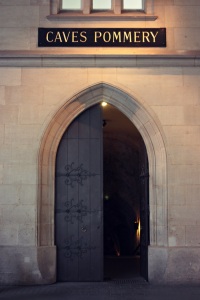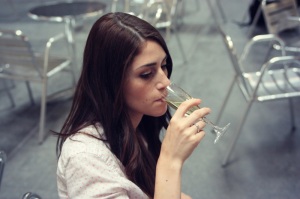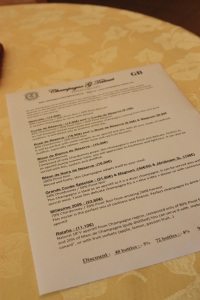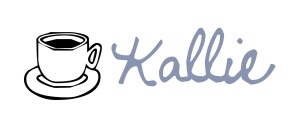And… We’re off! Upon leaving Dijon we rented ourselves a car and I was dubbed honorary driver, mostly because I was the only one brave enough to attempt driving in a foreign country for the first time. I was a little nervous to start, but turns out… it’s just about the same as driving in the states. Well, except there aren’t oversized trucks to dodge and the French REALLY like to use rotaries- which I didn’t hate because if I missed our turn I could just keep on going around. After doing my best to translate what the navigation voice was telling me I pulled out of the parking lot and headed north to Champagne.
After leaving the city this is what most of the drive looked like. It was nice to be out in the greenery after 5 nights of city living.
Our first order of business upon arriving in the Champagne region of France was to immediately consume champagne. Can I get an amen? We wandered into the
Pommery House, thinking we might have a champagne sampling but unaware of exactly the experience we were about to get in to.
The Pommery house was founded in 1858 by Alexandre Louis Pommery and Narcisse Greno. Pommery had a dream to create great champagne and Greno had the money to help. In 1874 the Pommery House create the first Brut in the history of champagne. Up until then, champagne had been much sweeter with a higher alcohol content. But Louise Pommery, the lady of the house, knew that the taste of the high-class was for something more light and less sweet. This decision to create the first Brut was the beginning of the Pommery legacy.
Our tour began by entering through the doors of the Pommery Caves.
As we descended the 116 stairs our tour guide told us the history of the Pommery Caves. Just after opening Pommery Vineyard Alexandre Pommery died, leaving a young Louise and their not even one year old daughter. In 1868 Louise bought a large area of land in Reims that no one else wanted because of it sat on top of old chalk mines. When people asked Madame Pommery what she was going to do with the land she told them she was going to build the most magnificent estate in Reims, and that, my friends, she did. She had 18 kilometers (about 11 miles) of corridors dug deep into the chalk. The chalk mines were the perfect place to age champagne because of their extremely high humidity. Then, on top of all the corridors, Louise Pommery built the beautiful Pommery house. (Not pictured because I was too excited to drink champagne to stop and snap a photo of it, oops.)
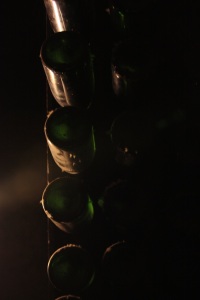
Upon entering the caves you were greeted by row after row of champagne. It was kind of like heaven…just darker. The champagne ages in these cellars anywhere from 16 months to 15 years. (Or longer if they were one of the prized “vintage collection,” kept behind a locked gate the Pommery House has one bottle from each year since opening. )
As a mentioned before the reason the chalk pits were ideal for champagne making has to do with the humidity. I only was able to gather about half of what our tour guide said partially because of her heavy accent and partially because of the loud noises of champagne making in the background. Either way, it made for some moldy bottles of champagne.
We were walked through just a small portion of the caves and I saw more champagne than I even knew existed in the entire world. And, I started to feel a little thirsty…
Alright, enough of all that history nonsense. Let’s drink some champagne already.
I used my exceptional palette to fully enjoy this classic champagne. Can you hear that sarcasm there? Good.
Can you get any happier than this? Surrounded by champagne, a good-looking man by my side… I think I’ll just never leave.
Psych. Eventually the champagne stopped flowing and so we decided we were in need of another source of the bubbly stuff. We hopped in our Peugeot (I was a class-act French driver by now) and drove south of Reims to Hautvillers. Famed for its wine-growing slopes, Hautvillers is also the past home, and now burial spot, of Dom Perignon. You probably know him from his famed champagne but he was actually a French monk and the first to blend grapes to create a vintage.
If the caves of Pommery weren’t heaven, then this place surely was.
Michael protested that I was spending too much time photographing the landscape, he was itching for a taste of the G.Tribaut Vineyard’s champagne.
It was a family affair at G.Tribaut. The women who gave us our tasting was the daughter of the couple who opened the vineyard. After hearing about her family the father strolled by carting a few crates of champagne and shaking everyone’s hand. G.Tribaut produced about 8 different kinds of champagne and we settled in to sample three. “Surprise us,” I insisted, and we ended up sampling the Blac de Blancs Reserve, Blanc de Noir and the Grand Cuvee. My favorite was the Blanc de Noir, a little sweet, a little dry, a lot delicious.
We sadly waved goodbye to Hautvillers, with a couple of bottles in our trunk, and drove off (literally) into the sunset. We also found a station on the radio we were quite keen on. “Drinking” radio? I can dig it.
I’m looking for a few more bloggers to collaborate on a Alphabet Weekend post, you can read more about it
here, or e-mail me, butfirstcoffeeblog@gmail.com, for more information




